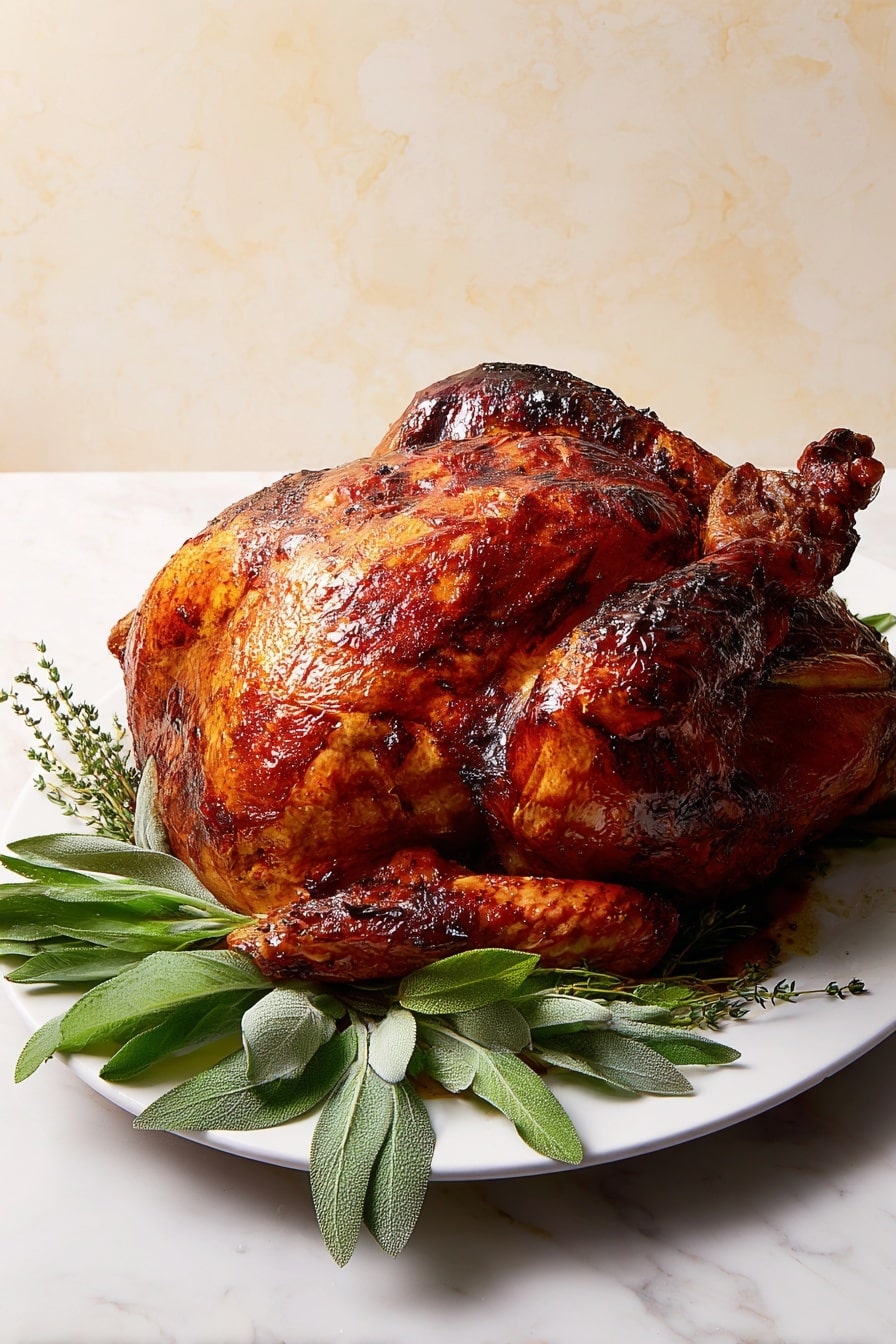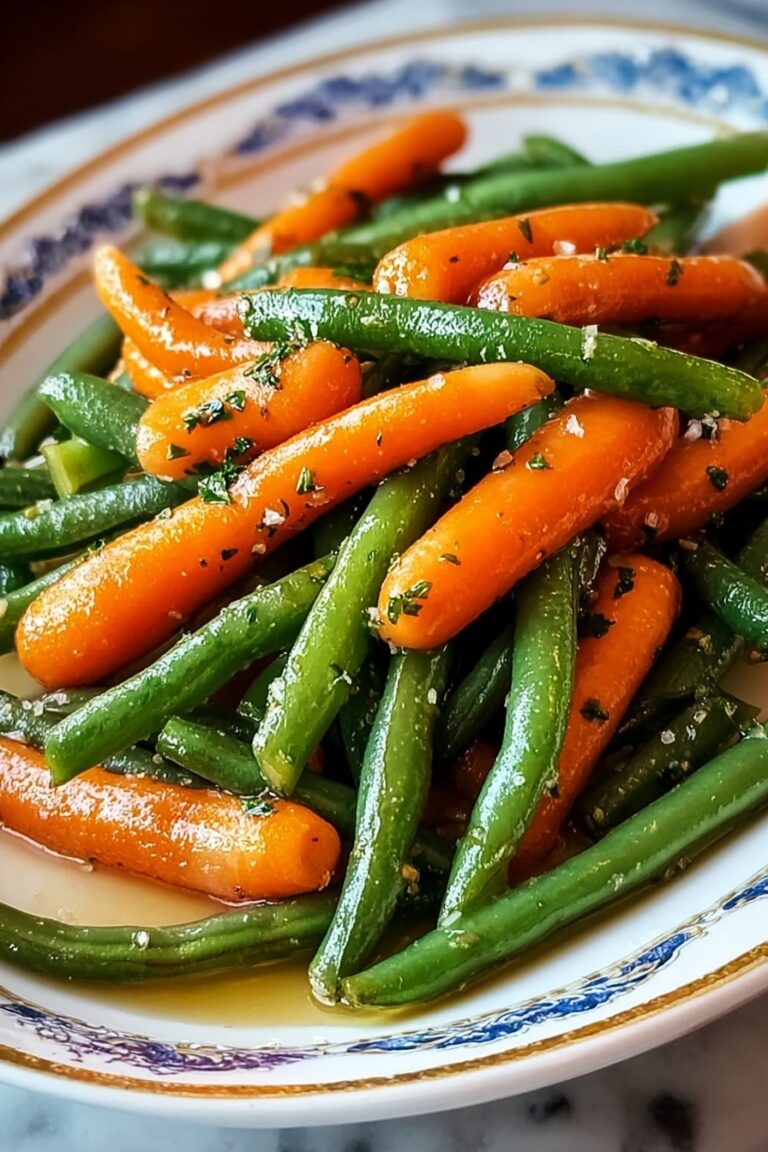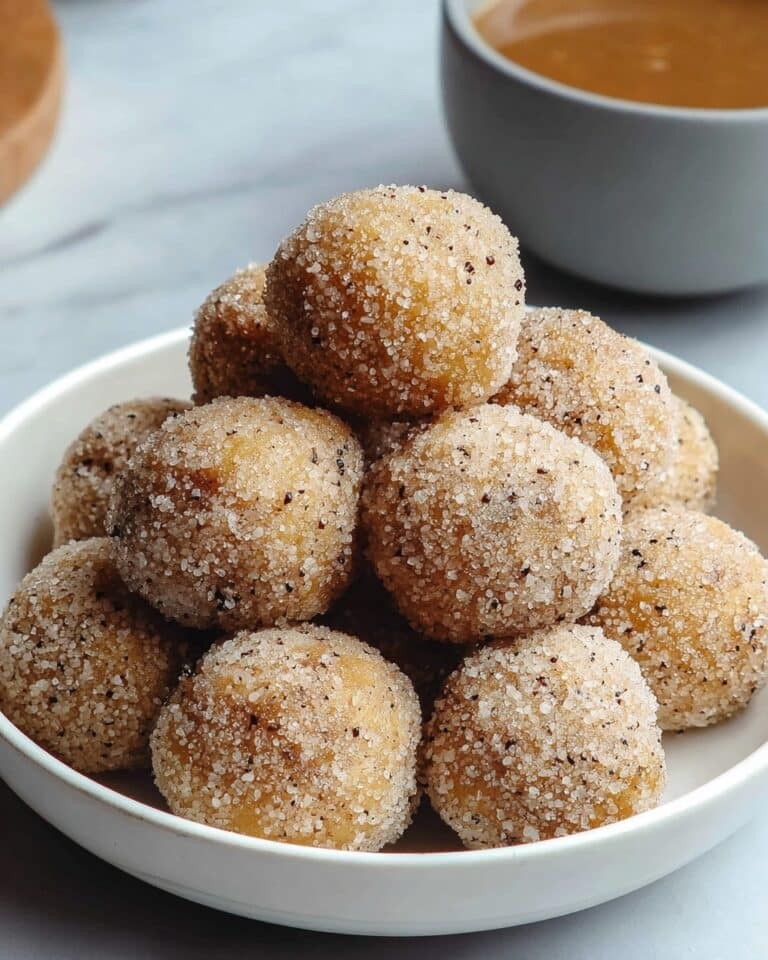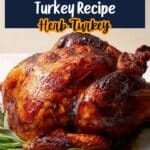- Turkey: Opt for a thawed 12-pound whole turkey; removing the neck and giblets is key for prep.
- Kosher salt: Great for seasoning deeply and helping the skin to dry properly.
- Freshly ground black pepper: Adds a bold, fresh kick to the herb rub.
- Baking powder: Helps crisp up the skin for that golden-brown finish.
- Dark brown sugar: Brings a subtle sweetness balancing the herbs and spices.
- Garlic powder: Gives a mellow, garlic flavor without overpowering the dish.
- Dried thyme: Classic poultry herb that enhances savory notes.
- Onion powder: Adds gentle depth and earthiness.
- Smoked paprika: Provides color and a slight smoky sweetness.
- Shallot or yellow onion: Placed inside the cavity for aromatic steam while roasting.
- Garlic head: Halved and roasted inside for mellow garlicky aroma.
- Lemon: Adds brightness and subtle citrus notes.
- Fresh sage and thyme bunches: Fresh herbs are crucial for aroma and flavor infusion.
- Neutral oil: Such as canola or vegetable oil to help the skin brown evenly.
Note: Exact ingredients and measurements are listed in the recipe card below.
Variations
I love that this Oven-Roasted Herb-Seasoned Turkey Recipe is super flexible, so I often tweak it depending on the occasion or what’s in season. Feel free to swap herbs or spices to match your tastes or dietary needs!
- Herb Swap: I sometimes replace fresh sage and thyme with rosemary and oregano for a different herbal profile.
- Spice Level: Adding a pinch of cayenne pepper gives the turkey a subtle heat without overpowering the herbs.
- Dietary Adjustments: For a low-sodium version, reduce the salt slightly and use unsalted oil to keep flavors balanced.
- Brining Alternative: If you prefer wet brining, soak the turkey in a saltwater solution overnight before applying the herb rub.
How to Make Oven-Roasted Herb-Seasoned Turkey Recipe
Step 1: Prepare Your Turkey and Roasting Pan
First, line your roasting pan with heavy-duty foil and set a rack inside to keep the turkey elevated — this helps the heat circulate for even cooking. Pat the turkey dry thoroughly, inside and out, using paper towels; moisture can prevent the skin from crisping properly. I always remove the wishbone before roasting — it makes carving the breast meat much easier later on. Just use a sharp boning knife to carefully loosen it, and set the turkey on the rack once done.
Step 2: Mix and Apply the Herb Seasoning
Using a spice grinder or mortar and pestle, combine the kosher salt, black pepper, baking powder, brown sugar, garlic powder, dried thyme, onion powder, and smoked paprika. I like to pulse mine a few times until the mix is finely blended — this ensures even seasoning. Then, gently separate the turkey skin from the breast meat with your fingers and rub this seasoning mix under the skin and all over the surface, including the inside of the cavity. It’s key to press the seasoning so it sticks well. Pop the turkey in your fridge, uncovered, for at least 12 hours or up to 2 days — this step amps up the flavor and dries out the skin a little for extra crispiness.
Step 3: Prep to Roast
When you’re ready to roast, arrange a rack in the lower third of your oven and preheat it to 450°F. Give the turkey another pat with paper towels to remove excess moisture, then stuff the cavity and neck opening with quartered shallot or onion, halved garlic head, lemon wedges, and fresh sprigs of thyme and sage. This creates beautiful, fragrant steam during cooking. Drizzle the turkey with neutral oil to encourage browning, then insert a leave-in probe thermometer if you have one — it’s a game changer for cooking accuracy.
Step 4: Roast and Monitor Temperature
Start roasting at 450°F for 30 minutes — this initial high heat jumpstarts browning. Then lower the oven temperature to 350°F and continue roasting until the breast meat reaches 155°F and the thigh hits 165°F. This usually takes about 1.5 to 2 hours more, but I recommend relying on your thermometer rather than clock-watch. Once done, let the turkey rest uncovered for 45 minutes before carving — the meat will stay juicy and the flavors settle beautifully.
Pro Tips for Making Oven-Roasted Herb-Seasoned Turkey Recipe
- Season Early: Don’t rush the seasoning step; letting the turkey sit uncovered in the fridge overnight dries the skin for maximum crispness.
- Use a Thermometer: I learned the hard way that visual cues aren’t reliable — a leave-in probe thermometer delivers perfectly cooked, juicy turkey every time.
- Don’t Overfill the Cavity: Too many aromatics can trap moisture and steam the turkey rather than roast it, so give your herbs and citrus a little breathing room.
- Rest Without Tent: Instead of covering the turkey with foil after roasting, I leave it uncovered so the skin stays crispy right up to serving.
How to Serve Oven-Roasted Herb-Seasoned Turkey Recipe

Garnishes
I usually garnish with fresh thyme sprigs and lemon wedges on the serving platter — it adds a vibrant, fresh touch that complements the savory turkey. For a bit of color and fragrance, scatter some roasted garlic cloves around the bird. These little details always get compliments and make the presentation pop.
Side Dishes
My family goes crazy for classic sides like creamy mashed potatoes, buttery roasted carrots, and a crunchy green bean almondine. Cranberry sauce with a zesty kick always pairs perfectly here, brightening the richness of the turkey. Don’t forget a good gravy made from the pan drippings— it’s the finishing touch that pulls the whole meal together.
Creative Ways to Present
For special occasions, I like to carve the turkey breast into thick slices and fan them on a large wooden board, surrounded by roasted seasonal vegetables and herb sprigs. Serving family-style like this invites everyone to dig in and creates a warm, communal vibe. Adding edible flowers or colorful microgreens can elevate the look if you’re hosting a fancy gathering.
Make Ahead and Storage
Storing Leftovers
After the feast, I always slice leftover turkey meat and store it in an airtight container in the fridge. It keeps well for 3-4 days, and you’ll find leftovers just as good reheated if stored properly. Keeping the skin separate in a paper towel-lined container helps it stay a bit crispy, if you want to enjoy that texture again.
Freezing
I’ve frozen cooked turkey before by wrapping slices tightly in plastic wrap and then placing them in freezer bags. This method helps the turkey preserve moisture and flavor for up to 3 months. Just thaw overnight in the fridge the day before you want to use it, and you’re good to go.
Reheating
To keep reheated turkey juicy, I like to warm it gently in a low oven (around 300°F) covered loosely with foil, or steam slices in a pan with a splash of broth on the stovetop. Avoid microwaving if you want to prevent drying out, but if it’s your fastest option, add a little water and cover tightly.
FAQs
-
Can I use a fresh turkey for this Oven-Roasted Herb-Seasoned Turkey Recipe?
Absolutely! While this recipe is demonstrated with a thawed frozen turkey, a fresh turkey works just as well. Just make sure it’s fully cleaned, and follow the same seasoning and roasting instructions for fantastic results.
-
What if I don’t have all the dried spices for the herb rub?
Don’t stress! You can simplify the rub by using just salt, pepper, garlic powder, and any fresh herbs you have on hand. The core flavors will still shine through, and the turkey will remain delicious.
-
Why is baking powder used in the seasoning?
Baking powder helps dry out the skin and contributes to the crispy texture that makes the turkey skin so satisfying. It’s a neat trick I discovered that takes roasting to the next level.
-
How do I know when the turkey is done without a thermometer?
While I strongly recommend using a meat thermometer for accuracy, if you don’t have one, look for clear juices running from the thickest part of the thigh and no pinkness in the meat. The turkey leg should feel loose at the joint. However, investing in a thermometer really improves your results.
-
Can I prepare the turkey on the day of roasting?
Yes, but I recommend applying the seasoning at least a few hours before roasting to allow the flavors to penetrate and the skin to dry a bit. For best results and crispy skin, seasoning overnight in the fridge is ideal.
Final Thoughts
This Oven-Roasted Herb-Seasoned Turkey Recipe has become my go-to for holiday celebrations and family dinners because it takes the guesswork out of roasting a perfect bird. I love sharing it with friends because it elevates the whole meal without extra fuss. Give it a try—you’ll discover a new favorite way to enjoy turkey that’s juicy, flavorful, and downright irresistible.
I absolutely love how this Oven-Roasted Herb-Seasoned Turkey Recipe delivers that perfect crispy skin and juicy, flavorful meat every single time. It’s the kind of turkey that steals the show at holiday dinners or special weekend meals – you’ll find the blend of herbs and spices creates a mouthwatering aroma that fills your kitchen and makes everyone eager to gather around the table.
When I first tried this recipe, I was amazed by how simple techniques like seasoning under the skin and a two-step roasting process transformed a plain turkey into something truly memorable. Whether you’re a seasoned home cook or making turkey for the first time, this Oven-Roasted Herb-Seasoned Turkey Recipe is worth trying for its dependable results and deep, savory flavors.
Why You’ll Love This Recipe
- Incredible Flavor: The herb and spice blend infused under the skin makes every bite flavorful and juicy.
- Perfectly Crisp Skin: Baking powder in the seasoning mix helps achieve that irresistible crispy skin.
- Easy to Prep Ahead: You can season the turkey up to 2 days before roasting, making it ideal for busy holiday schedules.
- Reliable Results: The roasting method ensures even cooking so your turkey won’t dry out.
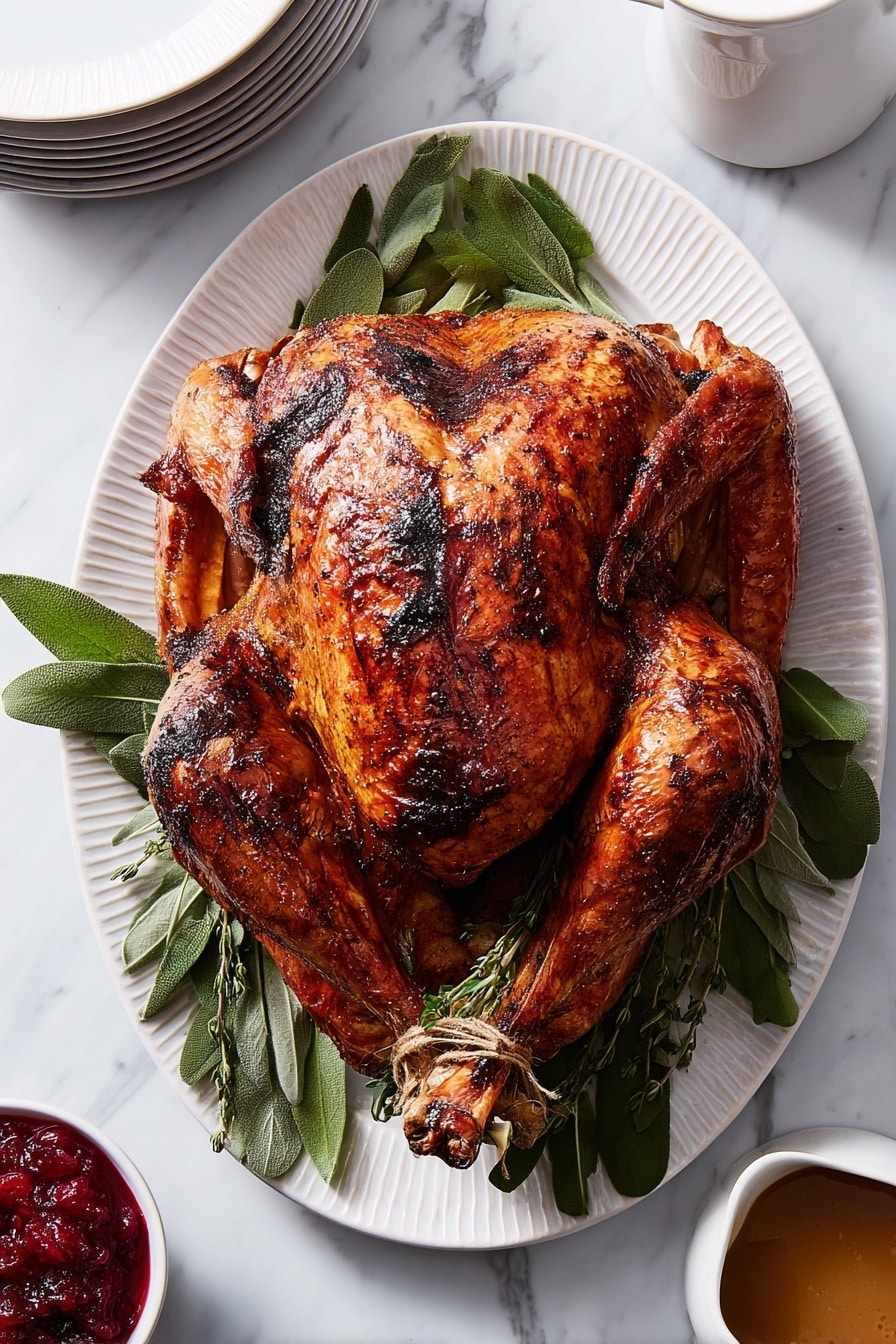
Ingredients You’ll Need
Each ingredient in this Oven-Roasted Herb-Seasoned Turkey Recipe works together to build layers of savory, aromatic flavor. Choosing fresh herbs and quality spices really takes this recipe from good to unforgettable.
- Turkey: Opt for a thawed 12-pound whole turkey; removing the neck and giblets is key for prep.
- Kosher salt: Great for seasoning deeply and helping the skin to dry properly.
- Freshly ground black pepper: Adds a bold, fresh kick to the herb rub.
- Baking powder: Helps crisp up the skin for that golden-brown finish.
- Dark brown sugar: Brings a subtle sweetness balancing the herbs and spices.
- Garlic powder: Gives a mellow, garlic flavor without overpowering the dish.
- Dried thyme: Classic poultry herb that enhances savory notes.
- Onion powder: Adds gentle depth and earthiness.
- Smoked paprika: Provides color and a slight smoky sweetness.
- Shallot or yellow onion: Placed inside the cavity for aromatic steam while roasting.
- Garlic head: Halved and roasted inside for mellow garlicky aroma.
- Lemon: Adds brightness and subtle citrus notes.
- Fresh sage and thyme bunches: Fresh herbs are crucial for aroma and flavor infusion.
- Neutral oil: Such as canola or vegetable oil to help the skin brown evenly.
Note: Exact ingredients and measurements are listed in the recipe card below.
Variations
I love that this Oven-Roasted Herb-Seasoned Turkey Recipe is super flexible, so I often tweak it depending on the occasion or what’s in season. Feel free to swap herbs or spices to match your tastes or dietary needs!
- Herb Swap: I sometimes replace fresh sage and thyme with rosemary and oregano for a different herbal profile.
- Spice Level: Adding a pinch of cayenne pepper gives the turkey a subtle heat without overpowering the herbs.
- Dietary Adjustments: For a low-sodium version, reduce the salt slightly and use unsalted oil to keep flavors balanced.
- Brining Alternative: If you prefer wet brining, soak the turkey in a saltwater solution overnight before applying the herb rub.
How to Make Oven-Roasted Herb-Seasoned Turkey Recipe
Step 1: Prepare Your Turkey and Roasting Pan
First, line your roasting pan with heavy-duty foil and set a rack inside to keep the turkey elevated — this helps the heat circulate for even cooking. Pat the turkey dry thoroughly, inside and out, using paper towels; moisture can prevent the skin from crisping properly. I always remove the wishbone before roasting — it makes carving the breast meat much easier later on. Just use a sharp boning knife to carefully loosen it, and set the turkey on the rack once done.
Step 2: Mix and Apply the Herb Seasoning
Using a spice grinder or mortar and pestle, combine the kosher salt, black pepper, baking powder, brown sugar, garlic powder, dried thyme, onion powder, and smoked paprika. I like to pulse mine a few times until the mix is finely blended — this ensures even seasoning. Then, gently separate the turkey skin from the breast meat with your fingers and rub this seasoning mix under the skin and all over the surface, including the inside of the cavity. It’s key to press the seasoning so it sticks well. Pop the turkey in your fridge, uncovered, for at least 12 hours or up to 2 days — this step amps up the flavor and dries out the skin a little for extra crispiness.
Step 3: Prep to Roast
When you’re ready to roast, arrange a rack in the lower third of your oven and preheat it to 450°F. Give the turkey another pat with paper towels to remove excess moisture, then stuff the cavity and neck opening with quartered shallot or onion, halved garlic head, lemon wedges, and fresh sprigs of thyme and sage. This creates beautiful, fragrant steam during cooking. Drizzle the turkey with neutral oil to encourage browning, then insert a leave-in probe thermometer if you have one — it’s a game changer for cooking accuracy.
Step 4: Roast and Monitor Temperature
Start roasting at 450°F for 30 minutes — this initial high heat jumpstarts browning. Then lower the oven temperature to 350°F and continue roasting until the breast meat reaches 155°F and the thigh hits 165°F. This usually takes about 1.5 to 2 hours more, but I recommend relying on your thermometer rather than clock-watch. Once done, let the turkey rest uncovered for 45 minutes before carving — the meat will stay juicy and the flavors settle beautifully.
Pro Tips for Making Oven-Roasted Herb-Seasoned Turkey Recipe
- Season Early: Don’t rush the seasoning step; letting the turkey sit uncovered in the fridge overnight dries the skin for maximum crispness.
- Use a Thermometer: I learned the hard way that visual cues aren’t reliable — a leave-in probe thermometer delivers perfectly cooked, juicy turkey every time.
- Don’t Overfill the Cavity: Too many aromatics can trap moisture and steam the turkey rather than roast it, so give your herbs and citrus a little breathing room.
- Rest Without Tent: Instead of covering the turkey with foil after roasting, I leave it uncovered so the skin stays crispy right up to serving.
How to Serve Oven-Roasted Herb-Seasoned Turkey Recipe

Garnishes
I usually garnish with fresh thyme sprigs and lemon wedges on the serving platter — it adds a vibrant, fresh touch that complements the savory turkey. For a bit of color and fragrance, scatter some roasted garlic cloves around the bird. These little details always get compliments and make the presentation pop.
Side Dishes
My family goes crazy for classic sides like creamy mashed potatoes, buttery roasted carrots, and a crunchy green bean almondine. Cranberry sauce with a zesty kick always pairs perfectly here, brightening the richness of the turkey. Don’t forget a good gravy made from the pan drippings— it’s the finishing touch that pulls the whole meal together.
Creative Ways to Present
For special occasions, I like to carve the turkey breast into thick slices and fan them on a large wooden board, surrounded by roasted seasonal vegetables and herb sprigs. Serving family-style like this invites everyone to dig in and creates a warm, communal vibe. Adding edible flowers or colorful microgreens can elevate the look if you’re hosting a fancy gathering.
Make Ahead and Storage
Storing Leftovers
After the feast, I always slice leftover turkey meat and store it in an airtight container in the fridge. It keeps well for 3-4 days, and you’ll find leftovers just as good reheated if stored properly. Keeping the skin separate in a paper towel-lined container helps it stay a bit crispy, if you want to enjoy that texture again.
Freezing
I’ve frozen cooked turkey before by wrapping slices tightly in plastic wrap and then placing them in freezer bags. This method helps the turkey preserve moisture and flavor for up to 3 months. Just thaw overnight in the fridge the day before you want to use it, and you’re good to go.
Reheating
To keep reheated turkey juicy, I like to warm it gently in a low oven (around 300°F) covered loosely with foil, or steam slices in a pan with a splash of broth on the stovetop. Avoid microwaving if you want to prevent drying out, but if it’s your fastest option, add a little water and cover tightly.
FAQs
-
Can I use a fresh turkey for this Oven-Roasted Herb-Seasoned Turkey Recipe?
Absolutely! While this recipe is demonstrated with a thawed frozen turkey, a fresh turkey works just as well. Just make sure it’s fully cleaned, and follow the same seasoning and roasting instructions for fantastic results.
-
What if I don’t have all the dried spices for the herb rub?
Don’t stress! You can simplify the rub by using just salt, pepper, garlic powder, and any fresh herbs you have on hand. The core flavors will still shine through, and the turkey will remain delicious.
-
Why is baking powder used in the seasoning?
Baking powder helps dry out the skin and contributes to the crispy texture that makes the turkey skin so satisfying. It’s a neat trick I discovered that takes roasting to the next level.
-
How do I know when the turkey is done without a thermometer?
While I strongly recommend using a meat thermometer for accuracy, if you don’t have one, look for clear juices running from the thickest part of the thigh and no pinkness in the meat. The turkey leg should feel loose at the joint. However, investing in a thermometer really improves your results.
-
Can I prepare the turkey on the day of roasting?
Yes, but I recommend applying the seasoning at least a few hours before roasting to allow the flavors to penetrate and the skin to dry a bit. For best results and crispy skin, seasoning overnight in the fridge is ideal.
Final Thoughts
This Oven-Roasted Herb-Seasoned Turkey Recipe has become my go-to for holiday celebrations and family dinners because it takes the guesswork out of roasting a perfect bird. I love sharing it with friends because it elevates the whole meal without extra fuss. Give it a try—you’ll discover a new favorite way to enjoy turkey that’s juicy, flavorful, and downright irresistible.

